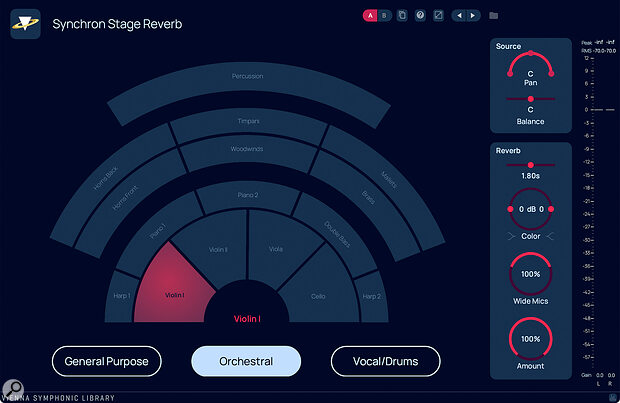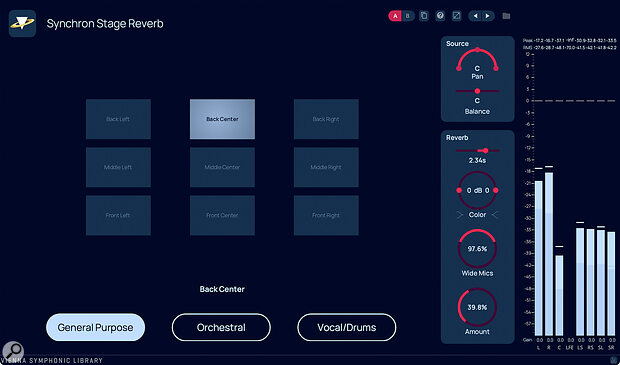 Screen 1: The default Orchestral preset offers the widest range of options.
Screen 1: The default Orchestral preset offers the widest range of options.
Based on Vienna’s Synchron Stage A, this new reverb promises to offer great sounds without taxing your CPU.
The latest plug‑in from Austrian software developers VSL comes in the form of a convolution reverb. Synchron Stage Reverb uses impulse responses captured with a Decca Tree mic array in VSL’s famous Synchron Stage A in Vienna — the recording venue for hundreds of music and film scores, including Captain America: Brave New World, Guardians of the Galaxy Vol. 3, Star Wars: The Acolyte and Mission Impossible – Dead Reckoning Part One, to name just a few fairly recent examples. Synchron Stage Reverb uses similar technology to that used in VSL’s MIR Pro 3D, which I reviewed in SOS September 2024, but is nowhere near as complex.
Synchron Stage Reverb comes in VST, VST3, AU and AAX formats, and is compatible with Windows 10 (latest update, 64‑bit) and 11, and macOS (Big Sur and higher) on an Intel Core i3 or Silicon machine. Licence activation is via iLok.
Setting The Stage
On opening an instance of Synchron Stage Reverb, it’s immediately clear what’s going on. The GUI is uncluttered, and there’s not a lot to tweak and fiddle with. Along the bottom are three preset mode buttons: General Purpose, Orchestral and Vocal/Drums. Above these, a display depicts the room placement for the selected preset. To the right, various controls allow you to tweak things further, and beyond these is an output level meter, which can be hidden by pressing the little meter icon that’s down in the bottom‑right corner.
The plug‑in opens in Orchestral preset mode (Screen 1), but it’s General Purpose (see Screen 2) that’s the most basic of the presets, so I’ll start there. There are nine positions to choose from: three on the left (back, middle and front), three in the centre (again, back, middle and front) and three on the right (you get the idea). The room positions in each preset correspond to where the instruments (the incoming source sound) are placed in relation to the fixed‑position Decca Tree array. So, obviously placing something at the back of the room further away from the mics gives the effect of more ambience, whereas placing something at the front makes things sound more present, with slightly less ambience.
 Screen 2: A 7.1 configuration of the General Purpose preset.
Screen 2: A 7.1 configuration of the General Purpose preset.
To the right of the placement selection display is a ‘Source’ box with two parameters, Pan and Balance. These adjust the source sound rather than the reverb effect — they allow you to place the source sound in relation to the room position selected, to achieve a more realistic sound. By the way, the Balance control can also be adjusted by clicking and dragging left or...
You are reading one of the locked Subscribers-only articles from our latest 5 issues.
You've read 30% of this article for FREE, so to continue reading...
- ✅ Log in - if you have a Digital Subscription you bought from SoundOnSound.com
- ⬇️ Buy & Download this Single Article in PDF format £0.83 GBP$1.49 USD
For less than the price of a coffee, buy now and immediately download to your computer, tablet or mobile. - ⬇️ ⬇️ ⬇️ Buy & Download the FULL ISSUE PDF
Our 'full SOS magazine' for smartphone/tablet/computer. More info... - 📲 Buy a DIGITAL subscription (or 📖 📲 Print + Digital sub)
Instantly unlock ALL Premium web articles! We often release online-only content.
Visit our ShopStore.
